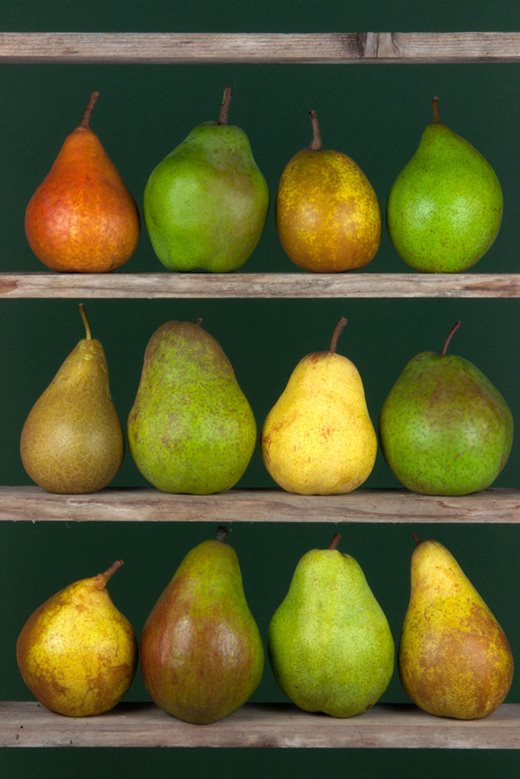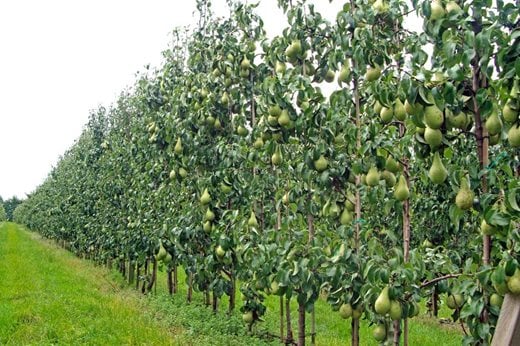A perfectly ripe pear takes some beating. Bursting with flavour and juice, home grown pears are a highlight of the harvest season
 Botanical name: Pyrus communis.
Botanical name: Pyrus communis.
Origins: Western China, but found in all temperate regions from Western Europe, North Africa and across Asia.
First cultivated: There is evidence of pears being used as a food source since prehistoric times. They were widely cultivated by the Romans with over 30 varieties recorded.
Types: More than 3,000 pear varieties are grown world-wide. For the best flavours and widest use in the kitchen, opt for a firm dessert variety
Skill level: Beginner to skilled – once they are established, minimal care is required.
Preferred location and conditions: Full sun or part shade (depending on variety) on fertile, moisture-retentive soil.
Good for containers: Yes – if produced on dwarfing rootstocks.
Harvest time: Late summer – early autumn.
Possible problems: Brown rot and pear rust.
Health benefits: Pears contain good levels of dietary fibre, antioxidants, minerals and vitamin A, C, E and K. They are low in calories and are considered an extremely safe food source for those with food allergies.
 Potted history
Potted history
The pear follows a similar development to that of the apple. The first proper British pear cultivation was implemented by the Romans. Slower to gain popularity, it was not until the mid 17th century that pear breeding caught up with apple development – each having around 60 cultivars in UK production by the 1640s. However there is mention in the Domesday Book (1086) of old pear trees being used as boundary markers.
Less than 200 years later, thanks to further developments of French and Belgian varieties by British horticulturists (most notably Thomas Andrew Knight early in the 19th century), 622 cultivars were recorded growing in the RHS gardens at Chiswick House, West London.
The 'Doyenne du Comice' pear was introduced to the UK from France in 1858 and together with the 'Conference' pear (1858) quickly became the dominate varieties in home production. 'Conference' pears now account for more than 90% of UK commercial production.
Why grow pears?
A perfectly ripe pear takes some beating. Bursting with flavour and juice, home grown pears are a highlight of the harvest season – hard, dry supermarket fruits pale in comparison. Store-bought produce centres around just a few common varieties, whereas gardeners have a wide selection of cultivars to choose from for something truly different for the kitchen or fruit bowl. Dwarfing rootstocks and the various pruning and training methods mean pears can be grown in almost any garden situation, no matter the available space.
 How to grow pears
How to grow pears
Autumn to spring is the best time to plant pears, though container grown trees can be planted at any time of year. Bare-root trees are available in the dormant season and these offer an economical and easy start to pear growing. Pears appreciate decent soil with plenty of added organic matter. Avoid shallow soils over chalk. A windbreak should be used on exposed sites during establishment.
For the best fruit production some annual pruning is required, and just as with the more commonly grown apples, this will differ depending on your preferred training method. Again like apples, but even more importantly for pear crops, pears require a pollinating partner. If space is limited, why not encourage a neighbour to plant one too? You can then split your harvests 50/50 for a share of each variety.
Trees should be staked and tied against wind-rock and for best fruit production feed each year in late winter/early spring with a high potassium feed. Newly planted trees should also be mulched in spring and autumn for the first three or four years to conserve moisture and reduce competition from weeds and grass.
Text provided by Mr Fothergill's.
See also
RHS advice: How to grow pears
Which pear variety is right for me?
How to prune pears

